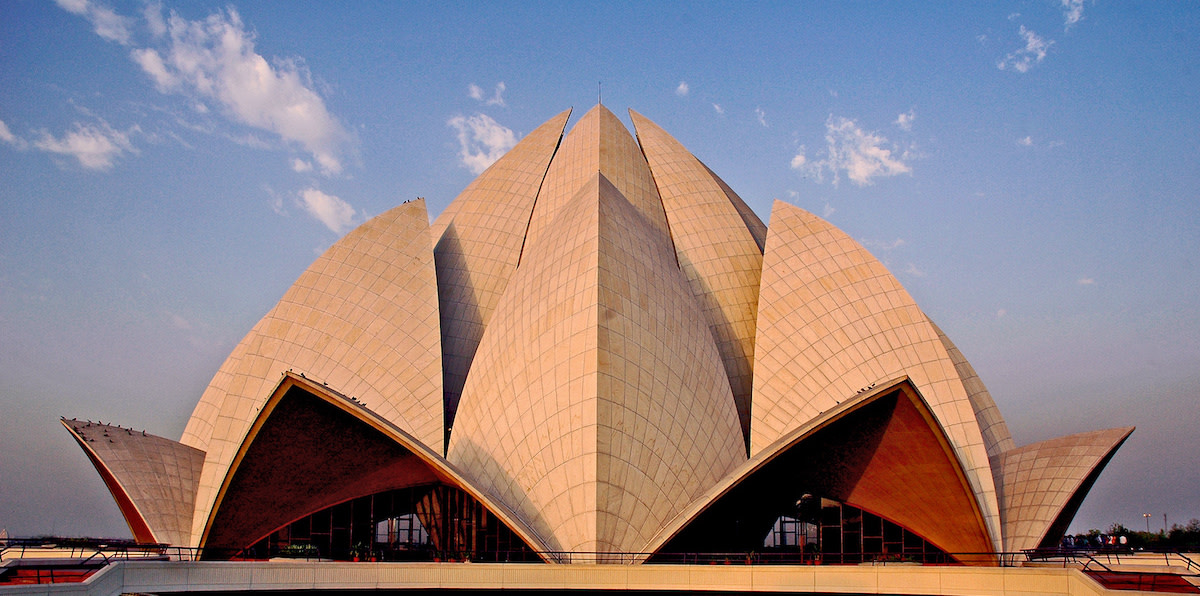Explore the Lotus Temple’s Architecture Style and History
Written by MasterClass
Last updated: Aug 3, 2021 • 3 min read
Located in New Delhi, India, the Lotus Temple is a house of worship erected in 1986. Learn about the history of the temple’s eye-catching architectural construction and some of its most notable characteristics.
Learn From the Best
What Is the Lotus Temple?
The Lotus Temple is a Bahá’í house of worship built in New Delhi, India, in 1986, famous for its unique architectural construction in the shape of a large lotus flower. The building consists of 27 free-standing petals made of concrete and coated in white marble (sourced from Greece’s Penteli mountain) and includes a central prayer hall, walkways, ground with ponds, and a greenhouse.
The Bahá’í Faith (founded in the nineteenth century in Iran) teaches that all religions are valuable as manifestations of God. Hence, the Lotus Temple is open to all visitors, regardless of religious affiliation, to use for worship. Eleven other Bahá’í places of worship exist worldwide, including temples in Kampala, Uganda; Wilmette, Illinois; and Panama City, Panama.
Many architects consider the Lotus Temple a prime example of contemporary expressionist architecture, alongside buildings like the Sydney Australia Opera House and the TWA Terminal at JFK International Airport.
A Brief History of the Lotus Temple
The Bahai Lotus Temple has its roots in the 1970s:
- Construction begins after a major donation. In 1976, Iranian architect Fariborz Sahba was hired to design a new Bahá’í temple in New Delhi. A Bahá’í practitioner, Ardishír Rustampúr of Hyderabad, donated his life savings in his will toward building a new temple, which the faith used to purchase land in the Bahapur village of New Delhi. Construction on the temple began shortly after.
- The temple opens to practitioners and the public. In 1986, the Lotus Temple was dedicated and opened to both practitioners of the Baháʼí Faith and the general public. Soon after its completion, it won several architectural awards, including the Institution of Structural Engineers’ award for excellence in religious art and architecture and the GlobArt Academy 2000 award.
- The temple breaks a world record. The Lotus Temple is the most visited building in India (passing up even the Taj Mahal) and one of the most visited religious tourist attractions in the world according to the Guinness World Records, boasting over 10,000 visitors per day.
A Look at the Architectural Style of the Lotus Temple
The Lotus Temple’s architectural style is characterized by:
- Biomimicry: The Lotus Temple is most famous for its distinct flowerlike shape, deliberately built to reflect the beauty and symmetry of the lotus flower important to many Eastern and Indian faiths, including the Bahá’í Faith, Hinduism, and Buddhism. The Lotus Temple is one of the most famous examples of biomimicry in modern architecture.
- Numeric symmetry: The number nine is sacred in the Bahá’í faith. Thus, the Lotus Temple (like many other Bahá’í houses of worship) incorporates the number nine in a symmetrical pattern for balance and beauty—for instance, the building is shaped in a nine-sided dome. The 27 concrete-and-marble petals that make up the structure are split into three different types: nine entrance leaves (which mark the doorways), nine outer leaves (which form the roof space), and nine inner leaves (which enclose the central hall in an interior dome).
- Significant structural integrity: The Lotus Temple may look delicate, but the construction team spent considerable effort ensuring that the building was sturdy enough to withstand regular earthquakes in New Delhi. To ensure the security of the building, construction teams formed each petal as a free-standing marble and concrete structure.
- Environmental consideration: In design, the Lotus Temple aimed to prioritize environmental sustainability, generating 20 percent of its electricity needs through a set of solar panels on the roof, using openings at the top and bottom of the building to encourage natural ventilation, and installing a large glass and steel skylight at the top of the structure to let in natural light.
Learn More
Get the MasterClass Annual Membership for exclusive access to video lessons taught by the world’s best, including Frank Gehry, Will Wright, Annie Leibovitz, Kelly Wearstler, Ron Finley, and more.
